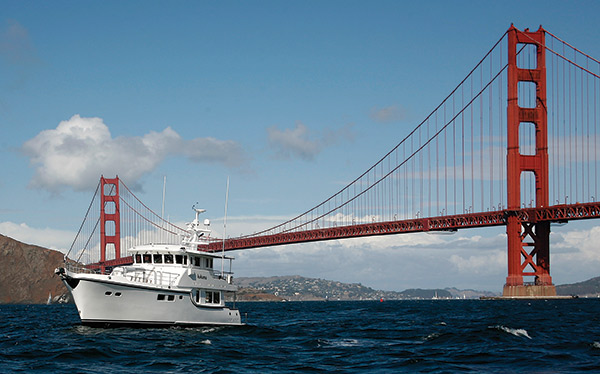
Words: Norris Comer // Photos: Jurg Beeli
A skipper at the helm of his or her yacht cannot help but gaze at the horizon and daydream of destinations beyond. Jogging the boat down the West Coast from Puget Sound to sunny San Francisco is probably as easy as turning the key and burning the gas, right? The route from north to south is even referred to as “downhill” due to the following seas produced by predominately northerly/northwesterly winds and the southbound California current. How hard can it be? We turn to three industry experts, two longtime cruisers turned yacht brokers Don Kohlmann and Martha Comfort and successful delivery captain Chris Couch, for what you need to know to get from the Space Needle skyline to the Golden Gate Bridge.
Unfortunately for the weekenders, the approximately 800-nautical-mile journey to San Francisco is not an undertaking to be tackled lightly. The stretch of coast from the Olympic Peninsula through Oregon waters and into Northern California is widely regarded as one of the roughest in the Pacific. A calm sunny day can transform into a nightmarish struggle for survival over the course of an hour. The same dramatic cliff faces that grace postcards represent certain lee-shore doom for a vessel. Minefields of crab pots can foul the route, and just about every safe harbor involves a tricky bar entrance.
However, the most important takeaway is that the voyage is truly won or lost at the dock with good decision-making. Our insiders agree that proper vessel maintenance and trip preparation are the most important elements to a successful and enjoyable journey south. You may not control the weather or tides, but you can plan ahead to pick a good window and hit a favorable slack tide over a bar. You may not control what breaks or malfunctions, but you do control what spares you have on board and the condition of your vessel. You can’t know it all, but you can learn what you will likely need. If you approach the downhill trek with forethought and sound decision-making skills, you and your crew will be enjoying sourdough bread bowls of chowder at San Francisco’s Fisherman’s Wharf in no time.
Maintenance, The True Journey
The first endeavor one takes to prepare for San Francisco starts at the dock with an all-encompassing maintenance regimen to ensure your vessel is as seaworthy as possible. As skipper, you can’t control everything that is going to happen, but you can, and must, ensure the condition of your vessel.
Don Kohlmann: Make sure that the running gear has been inspected. A lot of times you get a creeping growth on running surfaces like the propellers and shafts. A general underwater inspection is recommended. We use Emerald City Diving for our underwater services.
I would heartily suggest that your windlass be serviced at least once a year. That’s a really important piece of gear that could come into play at keeping you off the rocks.
Martha Comfort: I recommend a simple checklist-based maintenance program, and a number of people provide such lists. That kind of “80-point inspection” checklist tells you what’s ready for servicing. It doesn’t make any sense to leave anything up to chance. Every system on the checklist needs to be brought current, and that’s what people sometimes don’t do.
Chris Couch: What I do for a living is walk on boats I’ve never been on before and run them thousands of miles. The maintenance of the boat is the big fundamental thing I run up against. Years ago I created a maintenance checklist that is basically a reminder for everything. A lot of things fall through the cracks. Impellers, hoses, belts… these are the kinds of things that people just don’t think about. But the best maintenance someone can do is just use the boat. Go down every couple of weeks and crank it up. The worst thing you can do is just let it sit and not use it.
So this maintenance checklist that I created has maintenance and trip planning, weather tips, trouble shooting, and a list of ports. It’s all in a short, easy-to-read format for people to use and not sit on the shelf. I call it The Checklist because I used to fly corporate. In the aviation field, everything is about the checklist, so I tried to apply that to the marine side.
Preparation, Pack the Bags Well
Preparation for the voyage itself comes after the vessel is in excellent condition thanks to your proactive maintenance program. All three of our experts agree that certain spare parts are must-haves, and the ideal crew dynamic includes experienced hands.
Don Kohlmann: In terms of preparation, there are lots of things to think about with a big scope. Make sure the autopilot has been dialed-in. Autopilot is crucial to averting crew fatigue and making sure that general morale is good. Make sure you have spares. There are a number of different spares kits; some are assembled as suggested by engine manufacturers. Spares for the pressure water pump is crucial for
onboard operations.
Bring spare fluids for all mechanical systems, whether you have hydraulic systems associated with stabilization or other functions. ISO 32 is an example, and then of course spare oils and coolants for engines and generators.
Crucial is the replacement impellors. I think everybody carries them, but sometimes I think they get used out of the inventory and not always replaced in a timely fashion.
One thing people don’t have very often are spare inverter fuses, the class T-type. Although the inverter fuses don’t go out often, they can shut down the inverter system and be a bit of an inconvenience on board. I’ve heard of a lot of people on anchorages asking around for those, so it’s good to carry a couple of them. West Marine and Fisheries carry them for $25 or $30 a piece.